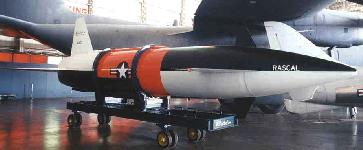





The "Rascal," originally designated as the XB-63, was an air-to-surface supersonic guided missile armed with a nuclear warhead. Its development was inaugurated in April 1946. The Rascal was intended as a "stand off" weapon, to be launched from Strategic Air Command (SAC) bombers as far away as 100 miles, thus reducing the manned bomber crew's exposure to enemy defenses in the immediate target area. Launched from its carrier aircraft, the missile would continue toward its predetermined target controlled by a self-contained inertial guidance system. The terminal dive began about 20 miles from the target. During this final phase of flight, the Rascal's course could be altered by signals from the launching "director" aircraft.
The first launch of a guided Rascal took place in October 1953 from a DB-47 director aircraft; various successful powered flights were demonstrated during later tests. The AGAM-63 program was terminated in late 1958, shortly before the first Rascal-equipped SAC unit was to become operational, in favor of the more promising and longer range "Hound Dog" missile.
Specifications |
|
| Span | 16 ft. 8 in. |
| Length | 32 ft. 0 in. |
| Height | 12 ft. 6 in. |
| Weight | 18,200 lbs. maximum at launch |
| Armament | Nuclear warhead |
| Engines | Bell XLR-67 three-chamber liquid fuel rocket engine of 10,440 lbs. thrust |

